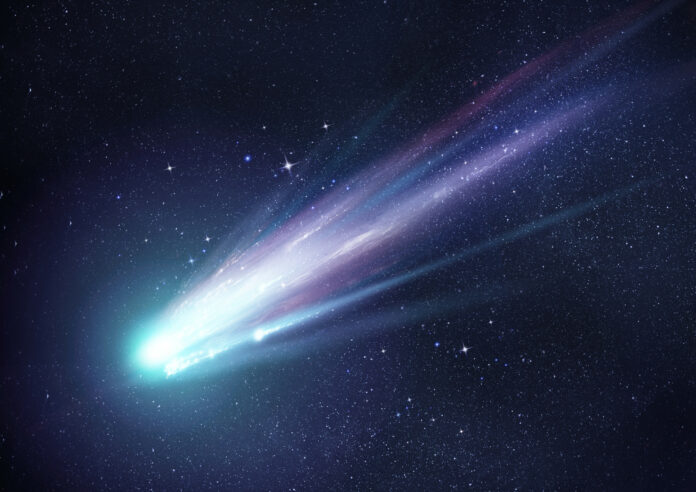A strange tailless comet is due to pass by the Earth in the next few months—and researchers want you to take pictures of it.
Studying these images of the comet, named C/2021 S3 Pannstars, could assist researchers in predicting and forecasting incoming bouts of solar wind.
This could help us learn how to protect infrastructure and technology on Earth and in space from the impacts of geomagnetic storms, according to a release from the University of Reading.
Too dim to be spotted with the naked eye, Comet C/2021 S3 PanSTARRS can be seen using binoculars or a telescope until the end of March and will move in a north-northeast direction through the constellations of Aquila, Sagitta, and Vulpecula.
ISTOCK / GETTY IMAGES PLUS
It may look a bit strange without the characteristic tail comets are known for having.
“What we are expecting to see may look rather unusual. When we talk about comets, people often think of a large, bright sphere followed by a long thin tail,” project lead Sarah Watson, a PhD researcher at the University of Reading, said in the statement.
“The comet we are observing may look different as its tail could ‘detach’ as it is buffeted by solar winds.”
The researchers hope that the public will take pictures of the comet, allowing them to study how it moves and changes as it travels through space.
“We need lots of timed photos of the comet to build up a picture of its journey through our solar system. This is a fantastic opportunity for amateur astronomers to get out their telescopes, capture a truly spectacular cosmic moment and make a big contribution to some important science,” Watson said.
The pictures of the comet’s tail will inform astronomers of the direction and strength of the solar wind, like a windsock in the breeze. If the comet is spotted with its tail becoming detached or wobbling, this will indicate to researchers that solar wind is increasing in strength.
Solar wind is a stream of charged particles, primarily consisting of electrons and protons, that are continuously emitted from the sun’s upper atmosphere, known as the corona. These charged particles are constantly being ejected from the sun due to its high temperature and the intense magnetic activity occurring in its outer layers.
Solar wind carries energy and magnetic fields throughout the solar system. It travels at varying speeds, typically about 1 million miles per hour, but it can occasionally reach much higher speeds during periods of increased solar activity, such as solar flares or coronal mass ejections (CMEs).
When this hits the Earth, it can cause geomagnetic storms in the atmosphere, which can lead to displays of the northern and southern lights, radio blackouts, and issues with satellites and the power grid.

ISTOCK / GETTY IMAGES PLUS
“Earth’s magnetic field usually channels the particles that cause auroras to latitudes like those of Alaska, so auroras are common there. The distorted magnetic field during a storm can bring these particles to hit the atmosphere at lower latitudes like those of the continental USA, making it glow and show auroras,” Martin Connors, a professor of space science and physics at Canada’s Athabasca University, told Newsweek.
“A magnetic field changing can cause electricity to flow, and magnetic fields come from auroras and also from electric currents further out in space (radiation belts) that get active in a storm. When these change, the electricity can get into our finely-tuned electric networks and cause them not to function well, to the point of even doing damage.
“Electronics in space and satellites are usually affected by particles since the radiation belts get activated in a storm to be ‘more radioactive’ and also affect regions lower down than usual. Humans are not directly very sensitive to magnetic fields so physical effects at Earth’s surface are minor. In space, humans could be affected by radiation, which we on the surface are protected from by our atmosphere.”
One survey from 2023 found that nine in ten space weather experts agree that Earth could suffer serious damage to its infrastructure without accurate forecasting of space weather. Images of Comet C/2021 S3 Pannstars may, therefore, help us to predict these events before they arrive and batten down the hatches to prevent too much damage.
Do you have a science story to share with Newsweek? Do you have a question about comets? Let us know via [email protected]
Uncommon Knowledge
Newsweek is committed to challenging conventional wisdom and finding connections in the search for common ground.
Newsweek is committed to challenging conventional wisdom and finding connections in the search for common ground.


